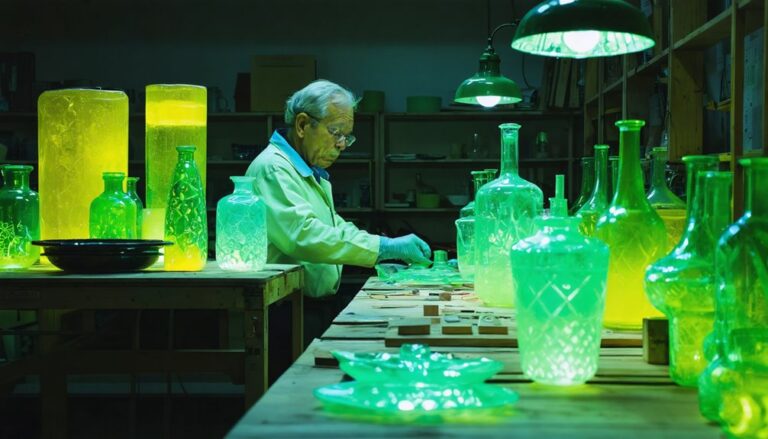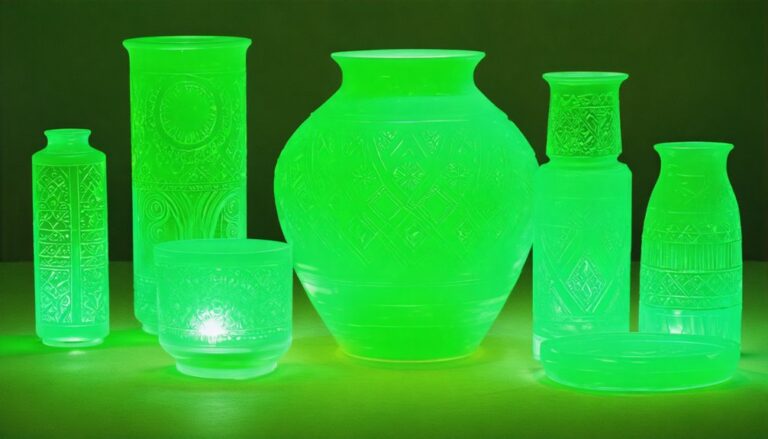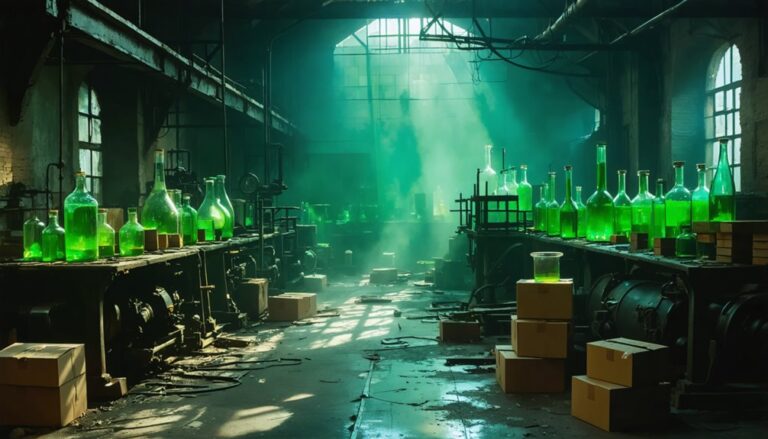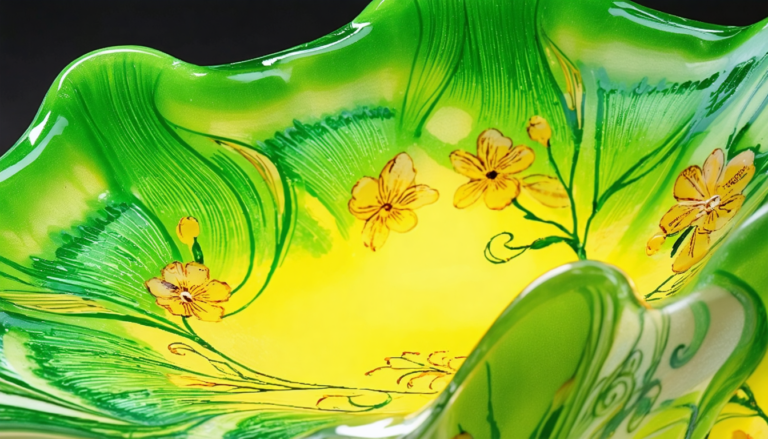The Origins of Uranium Glass in the 1830s
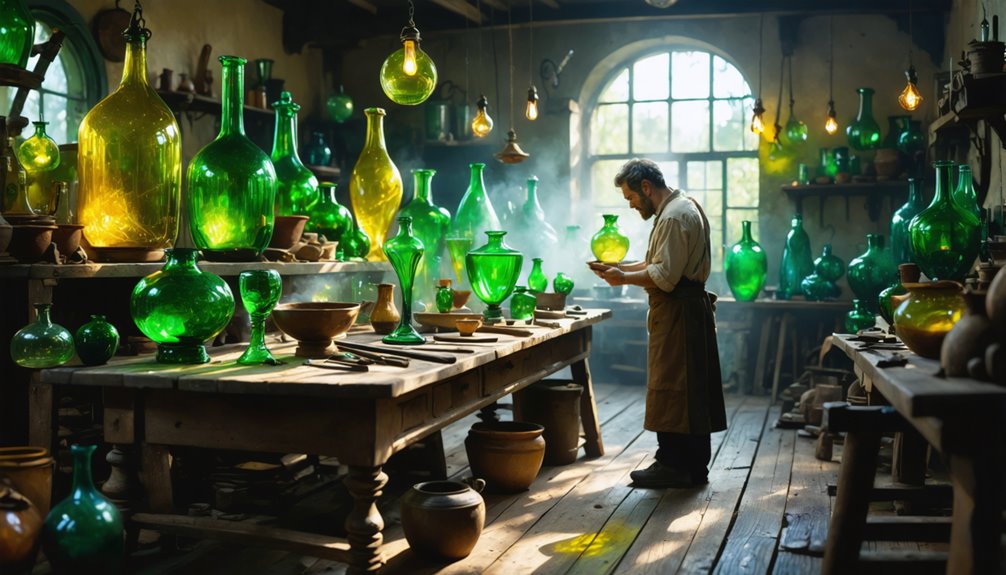
Uranium glass has a rich history that began in the 1830s in Bohemia, a region now part of the Czech Republic. Glassmakers in this area discovered uranium dioxide. They were fascinated by its ability to glow under ultraviolet light, producing a striking yellow-green hue. This unique property made uranium glass stand out.
Artisans, like Josef Riedel, were at the forefront of this innovation. They created vibrant colors such as Annagelb (yellow) and Annagruen (green). These pieces quickly gained popularity. They became fashionable items among collectors in Victorian England. People were drawn to the beauty and rarity of uranium glass.
The Habsburg Empire supported these glassmakers, allowing them to experiment and refine their techniques. As a result, uranium glass became a symbol of craftsmanship and creativity. It is a testament to the ingenuity of early glassmakers and the allure of new materials. There is much more to learn about this fascinating topic, from its production techniques to its cultural significance.
Key Takeaways
Uranium glass has an interesting history that dates back to the 1830s. Skilled artisans in Bohemia began to mix uranium dioxide into their glass. This gave the glass a unique yellow-green color that was quite captivating.
One of the notable figures in this early production was Josef Riedel. He created vibrant uranium glassware in Bohemia from 1830 to 1848. His work helped set the stage for the popularity of this type of glass. The Habsburg Empire played a crucial role in this development. Their support encouraged glassmakers to innovate and produce more uranium glass during this period.
Bohemian glassmakers achieved remarkable technical milestones with early uranium glass colors like Annagruen and Annagelb. These colors showcased their skill and creativity. In 1838, the Choisy-le-Roi Factory in France started to produce uranium glass as well. This collaboration with Bohemian artisans helped spread the appeal of uranium glass across Europe.
Overall, the early uses of uranium glass reflected both artistic expression and scientific curiosity. The combination of unique colors and the support from powerful entities like the Habsburg Empire made uranium glass a notable material in the history of glassmaking.
Discovery of Uranium as a Coloring Agent
In 1789, Martin Heinrich Klaproth discovered uranium in the mineral pitchblende. This discovery seemed insignificant at the time.
However, by the Victorian era, artisans began to see its potential in glassmaking. Uranium dioxide became a popular coloring agent, creating a distinctive yellow-green color in glass.
What made uranium glass stand out was its fluorescence. Under ultraviolet light, it glowed with a bright, captivating brilliance. This unique effect caught the eye of many artists and collectors.
Before long, uranium became a crucial component in decorative glass across Europe.
Bohemian glassmakers led the charge, skillfully incorporating this innovative material into their works. They opened new possibilities in glass art, marking a significant chapter in its history.
The combination of vibrant colors and glowing effects made uranium glass a sought-after treasure in homes and galleries alike.
Bohemian Glassmakers and Early Experiments
Uranium glass has a fascinating history, starting with the discovery of uranium by Martin Heinrich Klaproth. This discovery opened up new avenues for coloring glass. In the 1830s, glassmakers in Bohemia recognized the unique qualities of uranium dioxide. They skillfully blended it with their traditional glassmaking techniques. This experimentation resulted in striking colors like Annagruen and Annagelb, which weren’t only visually appealing but also glowed under ultraviolet light.
These innovative creations didn’t go unnoticed. The Habsburg Empire, known for its appreciation of art and craftsmanship, took an interest in the Bohemian glassmakers. This royal endorsement helped establish Bohemia as a key player in the uranium glass market. The region became known for its artistic innovation, influencing glass production throughout Europe.
Bohemian artisans were pioneers in using uranium glass. Their work demonstrated how natural elements could enhance artistic expression. The use of uranium added a new dimension to glass aesthetics, creating vibrant pieces that captivated collectors and royalty alike.
This period marked a significant evolution in the art of glassmaking, blending science and creativity in remarkable ways.
Klaproth’s Uranium Discovery
Uranium glass, often called Vaseline glass, has a fascinating history that starts in the world of glassmaking. In 1789, a German chemist named Martin Heinrich Klaproth discovered uranium. He quickly recognized its potential as a coloring agent for glass.
By the 1830s, skilled glassmakers in Bohemia began to experiment with uranium dioxide. They added this compound to their glass mixtures, creating beautiful and glowing effects.
The experiments revealed uranium’s unique fluorescent properties. This led to a striking yellow-green color in the glass. The vibrant hue captured the attention of artisans and consumers alike.
Factories like Choisy-le-Roi in France embraced Klaproth’s discovery. They produced stunning decorative glass pieces that combined artistic flair with scientific curiosity during the Victorian era.
These early uses of uranium glass not only enhanced decorative items but also showcased the blending of art and science. The allure of its glow and color made uranium glass a popular choice among collectors and enthusiasts.
Today, it serves as a reminder of the innovative spirit of that time.
Coloration and Glass Fusion
Klaproth discovered uranium’s exciting potential as a coloring agent. Soon after, skilled Bohemian glassmakers began to explore its use in their craft. They added uranium dioxide to hot glass mixtures. This led to the creation of striking colors. The shades included bright yellow, known as “Annagelb,” and a captivating yellowish-green called “Annagruen.”
Uranium glass became popular in the 19th century. Its unique colors and stunning fluorescent effects under ultraviolet light caught the public’s eye. When placed under UV light, these glass pieces glowed brilliantly. This was a hidden feature of uranium that amazed many.
The art of making uranium glass spread beyond Bohemia. Glassmakers across Europe valued these pieces. Their success came from careful experimentation with uranium dioxide. They perfected their glass fusion techniques.
The expertise of these artisans helped establish uranium glass as a cherished material in the world of art and design.
Bohemia’s Artistic Influence
Uranium glass has a fascinating history. In the 1830s, Bohemian glassmakers seized the opportunity to use uranium oxides in their glass mixtures. This innovation allowed them to create strikingly vibrant art pieces. The Habsburg Empire supported these artisans, which led to a burst of creativity that spread throughout Europe.
Josef Reidel was a prominent figure among these glassmakers. He introduced unique varieties of uranium glass, known as Annagruen and Annagelb. These names reflect the vibrant yellow-green colors that define these pieces.
The glass not only dazzled with its beauty but also exhibited a special feature: fluorescence under ultraviolet light. Collectors were enchanted by this glowing quality.
The allure of Bohemian uranium glass continues to captivate enthusiasts today. Its combination of artistry and scientific curiosity makes it a remarkable element of glassmaking history.
The legacy of these artisans persists, as their work inspires new generations of glassmakers and collectors alike.
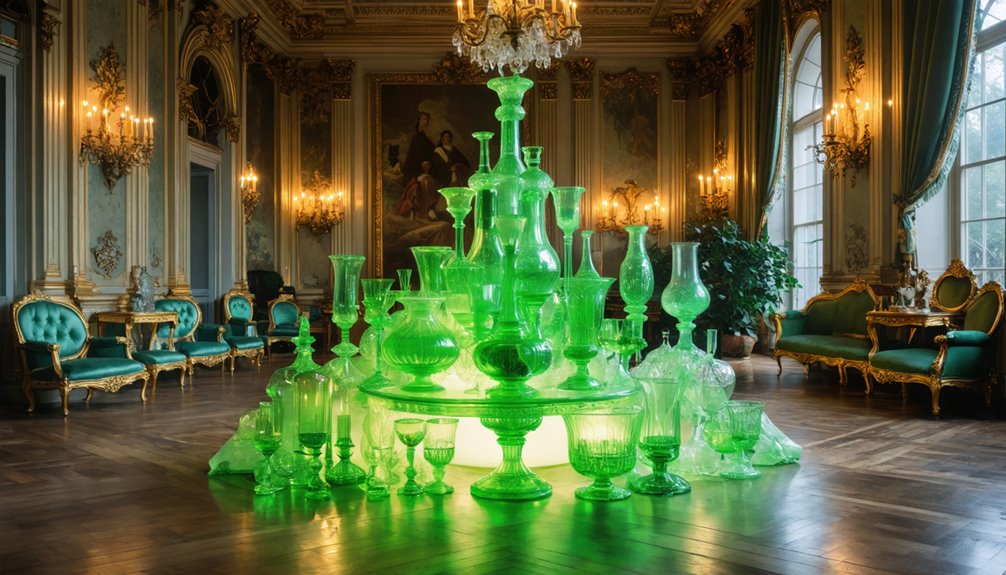
Popularity in Victorian England
Uranium glass, often called “Vaseline glass,” emerged in Victorian England in the mid-1800s. It quickly captivated the middle and upper classes with its striking yellow-green glow. This glassware had a unique ability to fluoresce under ultraviolet light, which fascinated consumers. It became a fascinating addition to many homes.
Artisans from renowned factories in Birmingham and Bristol eagerly used uranium as a coloring agent. They created beautiful decorative items and practical tableware. This trend showed Victorian England’s excitement for scientific advancement, making uranium glass a sought-after item for collectors. People wanted to showcase their taste and status in sophisticated social circles.
These pieces were more than just glassware; they were stylish statements for social gatherings. The intriguing glow under UV lighting made them stand out. Decorative uranium glass became cherished collectibles, admired for their beauty and uniqueness.
Artisan glassmakers across the country embraced this trend, adding to its popularity.
Influence of the Habsburg Empire
Uranium glass has a fascinating history that traces back to the Habsburg Empire. In the 1830s, this powerful dynasty supported Bohemian glassmakers. They encouraged these craftsmen to experiment with uranium dioxide in their glass. This support led to remarkable creativity and set Bohemia apart as a center for fine glasswork.
The Habsburg’s backing was crucial. It allowed artisans to explore new techniques and materials. This exploration turned uranium glass from a scientific oddity into an elegant decorative item. People across Europe began to admire its unique glow and vibrant colors.
Initially, uranium glass wasn’t just for decoration. It had practical uses too. Some artists incorporated it into everyday items. Others used it in scientific experiments.
Over time, the charm of uranium glass spread, and it became a symbol of artistic innovation. The legacy of the Habsburg Empire played a significant role in this transformation.
Habsburg Patronage Impact
During the Victorian era, glassmakers in Europe were eager to try new materials. The Habsburg Empire played a crucial role in the rise of uranium glass as a popular decorative art form. Their support was vital for Bohemian glassmakers. This backing allowed them to experiment with uranium glass and helped establish its place in 19th-century European markets.
The Habsburgs funded specialized factories, making it easier for artisans to create unique pieces. They also opened up international trade opportunities. This increased exposure helped boost the cultural prestige of uranium glass. As more people became aware of it, uranium glass gained wider acceptance across Europe.
Uranium glass wasn’t just about beauty; it also represented scientific progress. The vibrant colors and innovative designs caught the attention of many.
Being part of this artistic movement meant being part of something unique and celebrated beyond borders.
Bohemian Glass Innovation
The story of uranium glass begins with Bohemian glassmakers, who led the way in creativity and craftsmanship. During the Habsburg Empire, these artisans received strong support, which fueled their innovative spirit. In the 1830s, a talented glassmaker named Josef Reidel took a bold step. He started using uranium oxides in glassmaking. This decision changed the game, allowing him to craft a new type of glass that was both beautiful and unique. He called his creation “Annagruen.” This glass had a striking yellow-green color that caught the attention of many.
Victorian England embraced “Annagruen.” The vibrant hue of uranium glass symbolized the spirit of the time. It represented progress and curiosity about science. People were fascinated by its glow under ultraviolet light. Uranium glass became highly sought after, used in various decorative items and household goods.
Other innovators soon joined the movement. In 1838, the Choisy-le-Roi Factory in France expanded the production of uranium glass. Their efforts helped to spread the popularity of this remarkable material. Throughout the Victorian Era, Bohemian glassmakers continued to push boundaries, developing new techniques and designs. Their work influenced the aesthetics of glassware, leaving a lasting impact on the craft.
| Year | Innovator | Contribution |
|---|---|---|
| 1830s | Josef Reidel | Introduced uranium glass (“Annagruen”) |
| 1838 | Choisy-le-Roi Factory | Expanded uranium glass production to France |
| Victorian Era | Bohemian glassmakers | Advanced innovative techniques, influencing glass aesthetics |
Fluorescence: An Illuminating Property
Uranium glass has a rich history that dates back to the early 19th century. Initially, it was used in tableware and decorative items. The addition of uranium oxide gave glass a unique glow. This glow wasn’t just for show; it made the glass more appealing to buyers.
In the 1830s, glassmakers discovered that adding uranium to their glass not only created a vibrant, greenish hue but also enhanced its durability. People loved this eye-catching quality, and uranium glass quickly became popular. It adorned everything from goblets to vases.
During the Victorian era, uranium glass was all the rage. People found it fascinating to see their glassware glow under sunlight or blacklight. It drew attention in homes and at social gatherings. Collectors sought after these pieces for their beauty and unique properties.
However, not every piece of uranium glass glows. The fluorescence depends on the amount of uranium oxide used. Some items may glow brightly, while others mightn’t glow at all. This unpredictability adds to the excitement of collecting.
Today, uranium glass is valued by collectors for its historical significance and stunning aesthetic. It represents a blend of art and science. The appeal of these pieces goes beyond their visual allure; they tell a story of innovation in glassmaking.
Notable Manufacturers and Innovators
Uranium glass has an interesting history, especially in its early days. One key figure is Josef Riedel. He was a glassmaker in Bohemia from 1830 to 1848. Riedel created colorful glassware using uranium oxides. His designs featured vibrant shades like Annagruen and Annagelb. These hues caught people’s attention and made his pieces popular.
In France, the town of Choisy-le-Roi started making uranium glass around 1838. This boosted the material’s popularity across Europe. Shortly after, the famous Baccarat factory joined in, beginning production in 1843. Baccarat’s involvement added a layer of artistic value and commercial success to uranium glass.
The Habsburg Empire played a supportive role in this industry. They encouraged innovative glassmaking techniques. As a result, everyday glass items transformed into captivating art pieces.
These talented artisans left a lasting legacy that connects us to their impressive craftsmanship today.
The Emergence of Vaseline Glass
Uranium glass has a rich history, and Vaseline glass is a notable type of it. This unique glass first emerged in the 1830s in Bohemia. Glassmakers there started to add uranium oxides to their glass mixtures on purpose. This method resulted in a striking transparent glass that glows with vibrant yellow-green shades.
When exposed to ultraviolet light, it reveals an eye-catching fluorescence.
Vaseline glass got its name in the 1930s. The term reflects its resemblance to petroleum jelly. Factories in places like Choisy-le-Roi and Baccarat helped make this glass popular. Their skilled artisans crafted beautiful pieces that collectors cherish today.
Named in the 1930s for its petroleum jelly glow, Vaseline glass became popular thanks to factories like Choisy-le-Roi and Baccarat.
People love Vaseline glass for several reasons. It’s not just its beauty but also its unique properties. The fluorescence under blacklight adds a magical touch.
Collectors around the world seek these pieces, drawn to their historical significance and charming glow. Vaseline glass remains a fascinating topic in the study of decorative arts and the early uses of uranium in glassmaking.
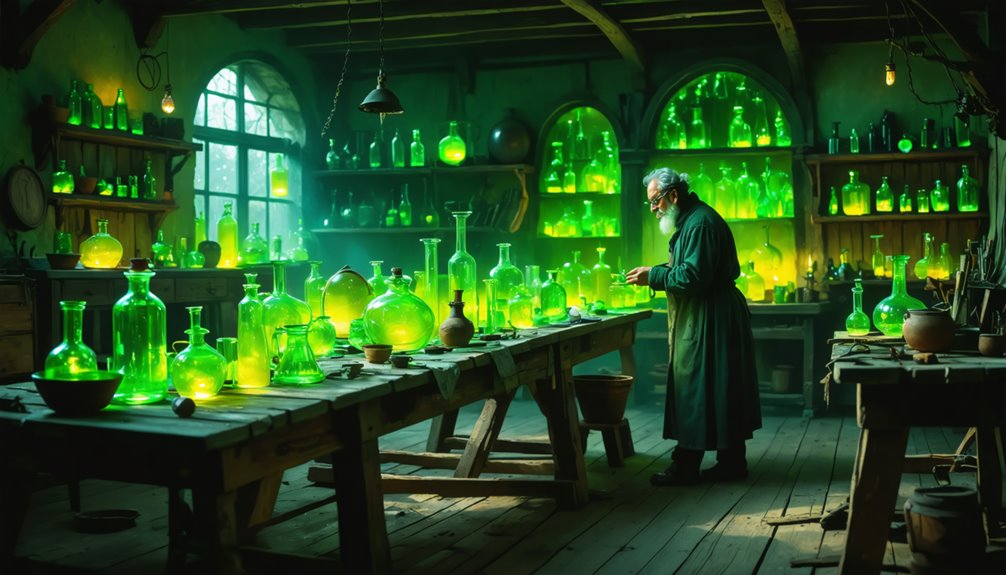
Impact of Wars and Regulations on Production
Uranium glass became popular in the late 19th and early 20th centuries. It was known for its bright colors and unique glow under ultraviolet light. However, major global conflicts and government regulations disrupted its production.
During World War II, the Manhattan Project required large amounts of uranium for atomic research. This led to the government confiscating uranium, which was essential for making uranium glass. As a result, many glass factories had to stop production. Some even closed down because they couldn’t get the materials they needed.
After the war, uranium glass made a comeback in 1958. Still, strict regulations limited the use of uranium, especially in consumer products. In the U.S., rules like 10 CFR 40.13 stated that glassware containing 10% or less uranium by weight didn’t need a special license. This change allowed some production to resume.
However, Cold War tensions continued to restrict the supply of uranium.
Today, uranium glass is mostly produced for decorative purposes. Safety and regulatory considerations still play a significant role in its production. The history of uranium glass reflects the impact of conflicts and laws on its availability and use.
Frequently Asked Questions
Was Uranium Used in the 1800S?
Imagine glass that glows with a unique greenish hue. This is uranium glass, a fascinating material used in the 1800s. During the 19th century, artists and craftsmen created stunning decorative pieces using uranium. They added the radioactive element to glass to achieve vibrant colors and striking effects.
Despite some worries about its safety, uranium glass became popular. It was not just for decoration; it found its way into various industrial uses. People admired its beauty, and it was a conversation starter in many homes.
Uranium glass is notable for its distinctive fluorescence under ultraviolet light. This feature captivated collectors and enthusiasts alike. While we now understand the health risks associated with radioactive materials, the historical significance of uranium glass remains. It showcases the creativity and innovation of the time.
How to Tell if Uranium Glass Is Vintage?
Uranium glass, also known as Vaseline glass, has a fascinating history. It contains small amounts of uranium, which gives it a unique glow under ultraviolet light. Early uses of uranium glass date back to the 1830s. It was popular for tableware and decorative items. People admired its vivid colors and striking patterns.
To identify vintage uranium glass, look for specific markings or labels. Authentic pieces often have the word “uranium” or “Vaseline” etched on them. Under UV light, these glasses emit a bright greenish hue, a clear sign of the uranium content. You can also notice different color variations that change depending on the thickness and type of glass.
Many collectors appreciate the historical significance of uranium glass. While checking for authenticity, it’s important to keep safety in mind. The radiation levels in this glass are generally low, making it safe for display in homes. Still, it’s wise to handle these pieces with care.
Is Vintage Uranium Glass Valuable?
Vintage uranium glass has a fascinating history. Its earliest uses date back to the 1830s. Initially, glassmakers included uranium to enhance the glass’s color and brilliance. This early uranium glass was popular in Victorian households. People enjoyed its unique glow under ultraviolet light.
In the 20th century, uranium glass became even more common. During the 1930s and 1940s, manufacturers like Fenton and Anchor Hocking produced large quantities. They made everything from dishes to decorative items. This glass was not only beautiful but also practical. Many households used it daily.
Collectors today appreciate uranium glass for its bright green hue and striking appearance. The glow under black light adds to its charm. Collectors often seek pieces that are rare or in excellent condition. The market for uranium glass continues to grow, fueled by nostalgia and a love for vintage items.
Why Was Uranium Glass Banned?
Uranium glass, also known as Vaseline glass, was once popular for its striking green color and unique glow under ultraviolet light. It was commonly used for dishes, decorative items, and art pieces.
However, concerns about health risks arose due to its radioactive content. Uranium is a heavy metal that can be harmful if ingested or absorbed in large quantities. As people became more aware of these risks, regulations tightened. Governments began to impose stricter safety standards for materials used in consumer products.
Environmental worries also played a role in the decline of uranium glass production. The manufacturing process raised questions about the impact on the environment and the safety of workers involved. These factors contributed to the growing unease among collectors and the general public.
As a result, many countries banned the production and sale of uranium glass. The once-celebrated items are now viewed with caution. Today, collectors appreciate these pieces for their historical significance, but they remain aware of the potential dangers associated with their radioactive nature.
Conclusion
Uranium glass has a fascinating history that began in the 1830s. Bohemian artisans discovered that uranium could create vibrant colors in glass. This unexpected find led to the creation of unique pieces that stood out for their striking fluorescence.
In Victorian England, this glass caught the attention of many. The Habsburg Empire and skilled glassmakers played a key role in advancing its production. They experimented with uranium, producing what became known as Vaseline glass. This glass was not only beautiful but also served various practical purposes, from decorative items to everyday tableware.
Even though wars and stricter regulations disrupted its production, uranium glass did not fade away. It remains a testament to human creativity and innovation. This accidental discovery transformed into a beloved art form. Today, nearly two centuries later, uranium glass still captivates collectors and enthusiasts, showcasing the intersection of science and artistry.
